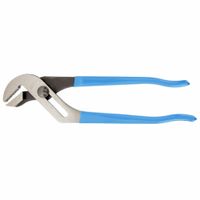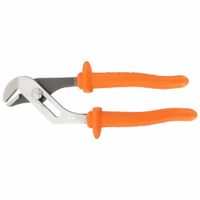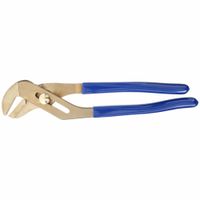Call +(254) 703 030 000 / 751 483 999 / 721 704 777
- Home
- Tools
- Hand Tools
- Pliers
- Tongue Groove Pliers Sets
.....Read More
Frequently Asked Questions
What are tongue-and-groove pliers used for?
Tongue-and-groove pliers, also known as channel locks, are versatile hand tools used for gripping and turning objects. They feature adjustable jaws that can be set to different widths, allowing them to handle a variety of sizes. The primary uses of tongue-and-groove pliers include:
1. **Plumbing Tasks**: They are commonly used in plumbing to grip and turn pipes, fittings, and nuts. Their adjustable jaws make them ideal for working with different pipe sizes and shapes.
2. **Automotive Repairs**: In automotive work, these pliers are used to grip and turn components like hoses, clamps, and other parts that require a firm grip.
3. **Electrical Work**: Electricians use them to tighten or loosen conduit fittings and to grip and pull wires.
4. **General Maintenance**: They are useful for general maintenance tasks around the home or workshop, such as assembling furniture, repairing appliances, or working on bicycles.
5. **Construction**: In construction, they are used for tasks like gripping and bending metal, holding materials in place, and adjusting metal framing.
6. **HVAC Work**: HVAC technicians use them to adjust ductwork, tighten fittings, and handle other components in heating and cooling systems.
The design of tongue-and-groove pliers, with their angled jaws and long handles, provides leverage and a strong grip, making them suitable for heavy-duty tasks. The adjustable feature allows for quick changes in jaw width, enhancing their versatility. They are an essential tool in many toolkits due to their adaptability and effectiveness in handling a wide range of tasks.
How do you adjust tongue-and-groove pliers?
To adjust tongue-and-groove pliers, follow these steps:
1. **Identify the Pivot Point**: Locate the pivot point where the two handles of the pliers intersect. This is where the adjustment mechanism is situated.
2. **Open the Pliers**: Hold the pliers with one hand on each handle. Open the jaws by pulling the handles apart. This will expose the grooves on one handle and the tongue on the other.
3. **Select the Groove**: Decide on the jaw width you need for your task. The pliers have multiple grooves that allow for different jaw openings.
4. **Adjust the Tongue**: Slide the tongue (the part of the upper handle that fits into the grooves) to the desired groove. Align the tongue with the selected groove on the lower handle.
5. **Lock the Position**: Once the tongue is in the desired groove, squeeze the handles together. This will lock the tongue into the groove, securing the jaw width.
6. **Test the Adjustment**: Before using the pliers, test the adjustment by applying pressure to ensure the jaws are securely set at the desired width.
7. **Re-adjust if Necessary**: If the jaws are not at the correct width, open the handles again and slide the tongue to a different groove. Repeat the locking process.
8. **Use the Pliers**: With the pliers adjusted, proceed with your task, ensuring a firm grip on the object.
By following these steps, you can effectively adjust tongue-and-groove pliers to fit various sizes of objects, providing a secure grip for your work.
What is the difference between tongue-and-groove pliers and regular pliers?
Tongue-and-groove pliers, also known as adjustable pliers or channel locks, have a unique design that allows the jaws to be adjusted to different widths. This is achieved through a sliding pivot point that can be set into various grooves, enabling the user to grip objects of varying sizes securely. The jaws of tongue-and-groove pliers are typically angled, providing a better grip on round or irregularly shaped objects. These pliers are commonly used for plumbing, automotive, and general maintenance tasks.
Regular pliers, on the other hand, have a fixed pivot point and are designed for gripping, bending, or cutting wire and other materials. They come in various types, such as needle-nose, slip-joint, and lineman's pliers, each suited for specific tasks. Regular pliers generally have straight jaws and are not adjustable, limiting their use to objects that fit within their fixed jaw width.
In summary, the main difference lies in the adjustability and jaw design: tongue-and-groove pliers offer adjustable jaw widths and angled jaws for versatile gripping, while regular pliers have fixed jaws suited for specific tasks.
Are tongue-and-groove pliers insulated?
No, tongue-and-groove pliers are not typically insulated. These pliers are designed for gripping and turning objects, and their primary function is mechanical rather than electrical. While they are versatile tools used in plumbing, automotive, and general repair tasks, they do not inherently provide protection against electrical shock.
Insulated tools are specifically designed to protect users from electrical hazards and are usually marked with a voltage rating indicating the level of protection they offer. They are often used by electricians and other professionals who work with live electrical circuits. Insulated tools have a layer of non-conductive material, such as rubber or plastic, covering the handles to prevent electrical current from passing through to the user.
If you require tongue-and-groove pliers for electrical work, it is crucial to ensure they are specifically labeled as insulated and meet relevant safety standards, such as ASTM F1505 or IEC 60900. These standards ensure that the tools have been tested and certified for electrical safety.
In summary, standard tongue-and-groove pliers are not insulated and should not be used for tasks involving live electrical circuits unless they are explicitly marked as insulated and meet the necessary safety standards.
What materials are tongue-and-groove pliers made from?
Tongue-and-groove pliers are typically made from high-strength materials to ensure durability and functionality. The primary material used is usually high-carbon steel or chrome vanadium steel. These materials are chosen for their excellent strength, toughness, and resistance to wear and tear. High-carbon steel provides a good balance of hardness and ductility, making it ideal for gripping and turning tasks. Chrome vanadium steel, on the other hand, offers enhanced corrosion resistance and durability, which is beneficial for tools exposed to various environmental conditions.
The handles of tongue-and-groove pliers are often coated with materials like rubber or plastic to provide a comfortable and non-slip grip. This coating helps reduce hand fatigue during prolonged use and ensures better control and safety. Some pliers may also feature ergonomic designs or cushioned grips for added comfort.
In some cases, the jaws of the pliers may be treated with additional processes such as induction hardening to increase their hardness and wear resistance. This treatment ensures that the gripping surfaces maintain their effectiveness over time, even with frequent use.
Overall, the combination of high-strength metals for the body and jaws, along with comfortable grip materials for the handles, makes tongue-and-groove pliers a reliable and essential tool in various applications.
How do you maintain tongue-and-groove pliers?
To maintain tongue-and-groove pliers, follow these steps:
1. **Cleaning**: After each use, wipe the pliers with a clean, dry cloth to remove dirt, grease, and debris. For stubborn grime, use a mild detergent and water, then dry thoroughly to prevent rust.
2. **Lubrication**: Apply a light machine oil or a specialized tool lubricant to the pivot joint and the grooves. This ensures smooth operation and prevents rust. Wipe off any excess oil to avoid attracting dust.
3. **Inspection**: Regularly inspect the pliers for signs of wear or damage. Check the teeth for wear and ensure the handles are intact. Replace the pliers if the teeth are worn down or if there are cracks in the handles.
4. **Adjustment**: Ensure the pliers adjust smoothly along the grooves. If they stick, clean and lubricate the grooves and pivot point. Make sure the adjustment mechanism is functioning properly.
5. **Storage**: Store the pliers in a dry place to prevent rust. Use a tool box or a tool rack to keep them organized and protected. Avoid leaving them in damp or humid environments.
6. **Rust Prevention**: If the pliers are exposed to moisture, dry them immediately and apply a rust inhibitor. Consider using silica gel packs in your tool storage to absorb moisture.
7. **Handle Care**: If the pliers have rubber or plastic grips, check for wear and tear. Replace grips if they are damaged to ensure a secure and comfortable hold.
By following these maintenance steps, you can extend the life of your tongue-and-groove pliers and ensure they function effectively when needed.
What sizes do tongue-and-groove pliers come in?
Tongue-and-groove pliers, also known as adjustable pliers or channel locks, come in a variety of sizes to accommodate different tasks and grip requirements. The sizes typically range from about 4 inches to 20 inches in length.
1. **Small Sizes (4 to 6 inches):** These are ideal for precision work or tasks in tight spaces where larger pliers would be cumbersome. They are often used for small plumbing repairs, electrical work, or delicate mechanical tasks.
2. **Medium Sizes (7 to 10 inches):** These are the most versatile and commonly used sizes. They are suitable for a wide range of household and professional applications, including plumbing, automotive repair, and general maintenance tasks. The 10-inch size is particularly popular for its balance of reach and control.
3. **Large Sizes (12 to 16 inches):** These pliers are used for heavy-duty tasks that require more leverage and grip strength. They are often employed in industrial settings, large-scale plumbing jobs, or when working with larger pipes and fittings.
4. **Extra-Large Sizes (18 to 20 inches):** These are specialized tools for very large applications, such as industrial plumbing, HVAC installations, or other heavy-duty tasks that require maximum leverage and jaw capacity.
The choice of size depends on the specific application, the space available to work in, and the amount of force required. Each size offers different jaw capacities and handle lengths, allowing users to select the most appropriate tool for their needs.


